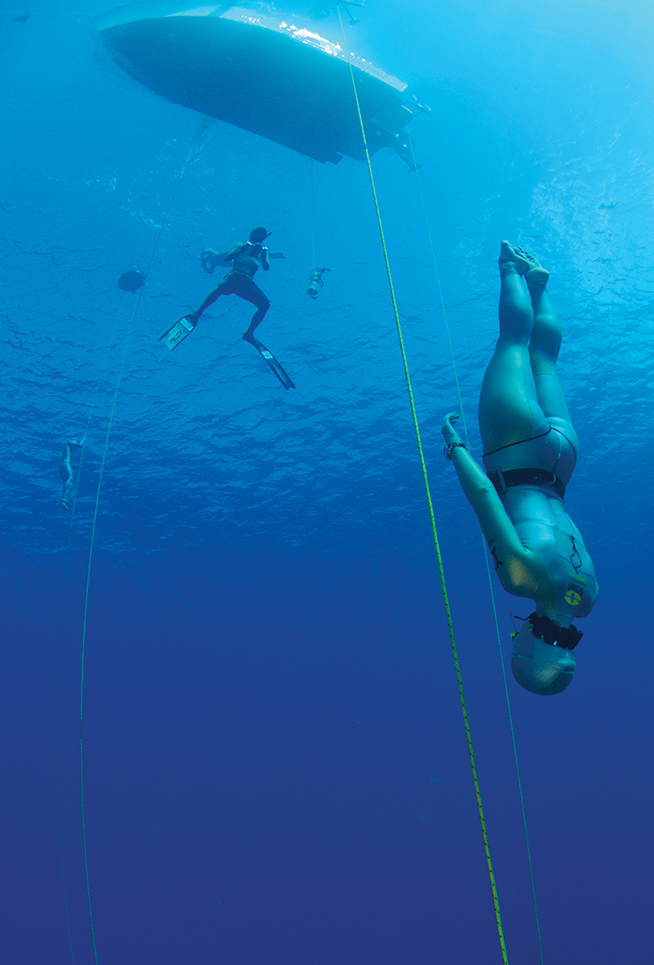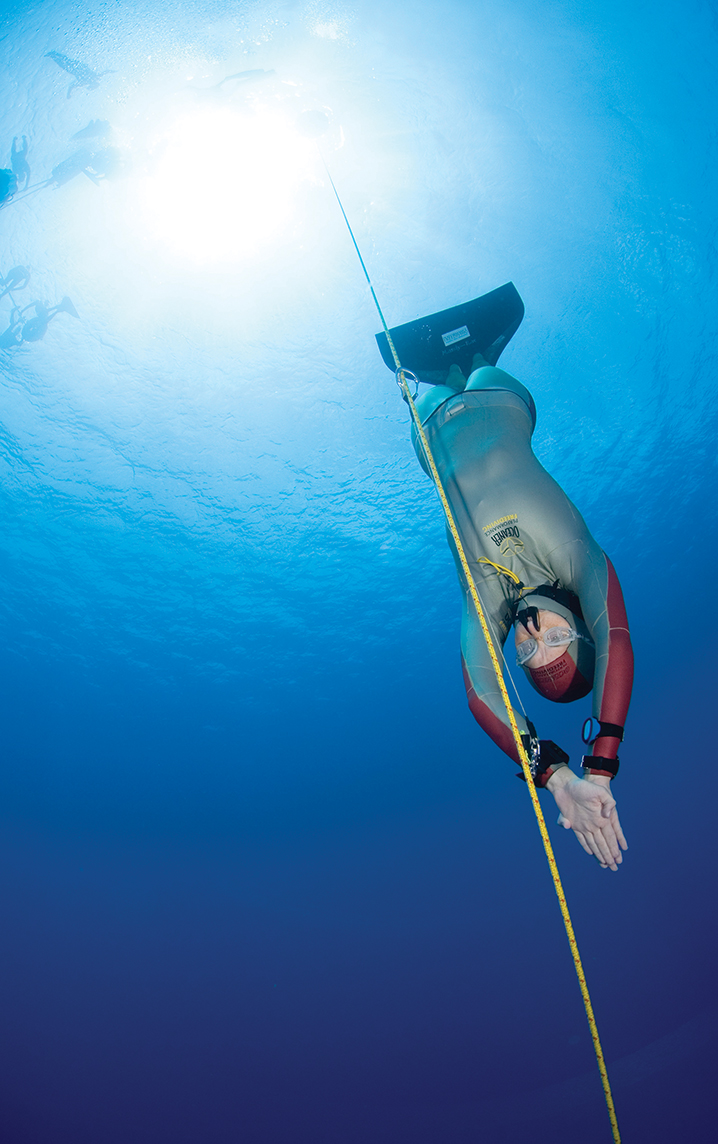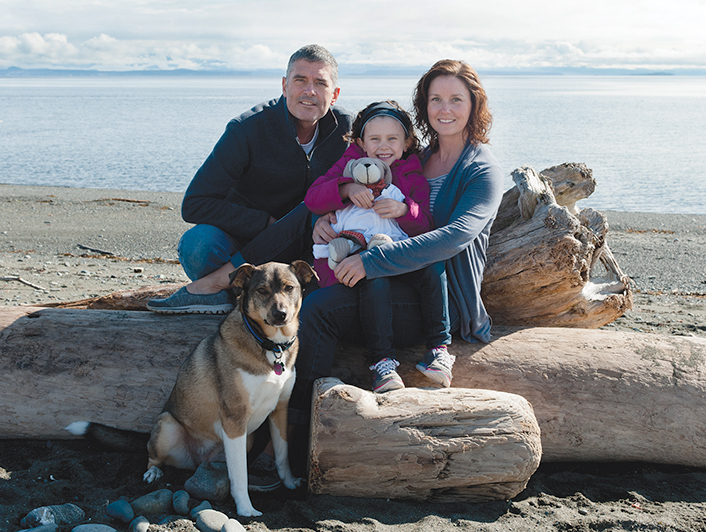In 2002, Mandy-Rae Cruickshank stopped breathing for more than six minutes.
Instead of CPR, she was given a trophy.
For nearly a decade, the 41-year-old Campbell River woman was among the pre-eminent female competitors in the extreme sport of freediving. She held seven world records, including a 136-metre (447-foot) ocean dive that made her the world’s deepest woman.
All of it without a single oxygen tank.
“It not only frees you from all the equipment that you have on, but you feel a lot more free in the water, like you belong there,” said Mandy-Rae. “I’ve been deeper now on a single breath than I would have been with the tanks.”
Freediving has taken her much further than the depths of the ocean. With her coach, business partner and, now, husband Kirk Krack, Mandy-Rae has traveled the world representing Canada, trained divers, swimmers, military forces, movie stars — and a magician — appeared on the Oprah Winfrey show and in an Academy Award-winning documentary, and taken steps to protect at-risk marine species and the environment itself.
“Anyone who spends as much time in the water as we do develops a special appreciation for it,” she said. “I think that’s one of the downfalls to our ocean; there are so many people who never get to experience what it’s l ike to be in and under the water, and everything it does for us and what it contains. They’ve never had that experience swimming with wild dolphins or whales or sharks.”
ike to be in and under the water, and everything it does for us and what it contains. They’ve never had that experience swimming with wild dolphins or whales or sharks.”
Neither Mandy-Rae nor Kirk seemed destined for that future as youths. Both were raised on the prairies — Mandy-Rae in Alberta, Kirk in Saskatchewan — but both developed an affinity for the water early on.
As a teen, she competed in synchronized swimming at the national level with the Edmonton Auroras, and, after receiving SCUBA lessons as a 13th birthday present, went on to get her SCUBA certification while diving in the lakes around Jasper and Banff.
“I wanted to go into marine biology to study great white sharks; that was my dream,” Mandy-Rae said. “Then I met a biologist who did it, and he talked me out of it. My parents must have loved that. It was their idea that we meet.”
By the time she graduated from high school she had decided to become a SCUBA instructor, and was accepted into a Professional Association of Diving Instructors (PADI) school in Sidney. After completing the course she returned to Alberta for two months, but quickly decided she preferred the coast and moved to Victoria after finding a job in a dive shop.
So what’s the difference between ocean diving and lake diving?
“Lake diving? It’s boring,” Mandy-Rae said. “I think I saw one fish in five years. My first dive here, I think I stayed in 15 to 20 feet of water for as long as my tank lasted. I was blown away by how much colour and all the things you can see.
“So it was, okay, I need to be out here.”
Kirk, meanwhile, had attended the same PADI school several years earlier. He earned his SCUBA certification and bought his own dive shop in Saskatoon at age 20. When he sold the business to move to Vancouver, he met Mandy-Rae while she was managing a dive shop there. She was taken by his description of technical diving, which offers more challenges than recreational SCUBA, and decided that was the direction she wanted to take her diving.
Two years later, Kirk moved to the Cayman Islands, where he became a dive instructor and boat captain.
“That’s really when I got into freediving,” said Kirk. “Freediving was something I always did, but I didn’t know it was freediving. I thought it was snorkeling.”
He spent nearly four years in the Caymans, and when he returned to Canada he returned to Mandy-Rae’s shop and began extolling the virtues of freediving.
“I’d still been working on my technical courses, and all of a sudden it’s all freediving this and freediving that, because he’d trained someone to a world record. It’s all he would talk about.”
Highlighting her background as a synchronized swimmer, where she spent much of her time upside-down, holding her breath, Kirk eventually convinced Mandy-Rae to give freediving a try.
“He’s very good at convincing,” Mandy-Rae said. “Not only did I try to get into technical (SCUBA), but I followed him into freediving. Then I married him.”
“It’s called neural linguistic programming,” Kirk joked.
Whatever it was, it stuck. After a year of training, the pair formed the first Team Canada to compete in the International Freediving and Apnea Championships in Nice, France. Mandy-Rae was struck by the status of the sport in Europe, where autograph hounds sought out their favourite divers like rock stars.
“After that I went to Kirk and said, ‘I want to do a world record,'” she said. “He said, ‘You have no idea how much work this is gonna be.'”
She did the work, and also benefits from a rare ability to “equalize” her underwater pressure hands-free, while upside down. Most divers have to pinch their nose shut and blow to “pop” the pressure on their eardrums as they descend.
When she reached 101 metres depth on a no-limits dive (with the aid of a sled to descend and an air bag to return to the surface) in 2000, Kirk began preparing for an attempt at the women’s world record, which stood at 130 metres.
The two travelled to the Caymans the following September, where Mandy-Rae reached 136 metres to become the world’s deepest woman. The static apnea record — lying face-down in a pool for six minutes, 16 seconds — followed the next year.
“It’s a huge mental challenge,” she said. “You’re holding your breath. It’s not comfortable at all, and eventually you start going through diaphragmatic contractions, which is kind of like hiccups, only you’re not breathing. You’re trying not to fight it, but it’s hard not to fight the lack of air.”
From there, Mandy-Rae claimed her only record achieved in Canadian waters, a constant, no-fins dive — basically, breaststroking down and back — of 41 metres in the waters of Howe Sound, just outside Horseshoe Bay, in 2004.
“We wanted to do it here, but it’s so much more challenging in cold, dark waters,” she said. “I had two suits on to stay warm during warmups, and during the final breathe-up Kirk peeled the top layer off so I was down to one, three-mil suit so I could move.”
She went on to extend that record to 50 metres in the Caymans in 2005, and added records in free immersion (74 metres) and constant ballast with fins (78 metres) in 2006. It was the largest one-time jump in the constant ballast with fins record, and she extended it to 88 metres in 2008.
“That’s one of the harder disciplines and, for most freedivers, the one they want,” Mandy-Rae said. “It takes a lot of physical ability.”
The couple married in 2006. Mandy-Rae continued to break records under her maiden name, “to avoid confusion,” but has since taken Krack as her last name.
During this time, the pair were approached through Performance Freediving, the company Kirk founded in 2000, by illusionist David Blaine. They coached and provided 24-hour safety for Blaine’s Drowned Alive act at New York’s Lincoln Centre in 2006, and two years later appeared with Blaine on Oprah Winfrey’s show as he performed a world-record breath hold.
They recently returned from Europe, where Kirk was coaching a certain A-list actor for underwater work in an action-thriller film scheduled to come out this year.
That was no big stretch because Mandy-Rae and Kirk played real-life action-thriller roles in the 2009 documentary The Cove, about the annual dolphin slaughter in a small, secretive inlet near Taiji, Japan.
Their involvement began when Kirk was approached at a diving trade show by representatives of the Oceanic Preservation Society. They had received financing for a film project to highlight problems in the ocean environment and wanted to film a female diver swimming with humpback whales.
“Kirk said, ‘Oh, I have just the person for you,'” Mandy-Rae said with a laugh. “A week later, I got a call from someone who explained it and I said, ‘Yeah, I want to do this.'”
She insisted on a safety diver to accompany her, which brought Kirk into the project as well. Mandy-Rae said she later heard the filmmakers joking that she just wanted her boyfriend along, but Kirk proved worth his weight — and a spot on the payroll — when the underwater camera crews with their air tanks proved unable to keep up with the action as Mandy-Rae swam with whales and dolphins.
“They’re just too bulky to move through the water,” she said. “So Kirk said at one point, ‘Give me the camera.’ So most of the shots with me and the whales was him filming it on free dive.”
Then they traveled to Taiji to meet director Louie Psihoyos and the production crew for what they thought was going to be a routine shoot in 2008. Until then, Mandy-Rae says, Psihoyos was unsure how his footage would be utilized. But after meeting former dolphin trainer-turned-activist Ric O’Barry and learning of the Taiji dolphin hunt, Psihoyos decided to try to access the highly restricted Cove using elaborately camouflaged cameras hidden in rocks and nests, night-vision cameras and hydrophones placed on the floor of the cove.
The plan was so secretive that Kirk and Mandy-Rae were not notified until they were brought into Psihoyos’s hotel room and told of their part in the filming — breaching the security and freediving to the bottom to place cameras and hydrophones in the killing bay in the dark of night.
“All the guys had ear buds so we were in communication,” Kirk said. “We had a flare (infra-red) camera so we could see where their guards were. In our socks we had laminated numbers for the U.S. and Canadian consulates and lawyers.”
Psihoyos and his elite team established an evacuation plan in the event they were surprised by police or guards, but, as Mandy-Rae said, “We had our own plan.”
 “If we were discovered, Mandy-Rae and I said we’ll jump back into the water, we’ll swim out to the middle of the ocean where they can’t see us, and we’ll swim along the shoreline until we get back to our hotel.”
“If we were discovered, Mandy-Rae and I said we’ll jump back into the water, we’ll swim out to the middle of the ocean where they can’t see us, and we’ll swim along the shoreline until we get back to our hotel.”
The real-life suspense of the documentary led one reviewer to describe it as “Jason Bourne meets Flipper” and Time magazine’s Mary Pols said it “puts Hollywood capers like Mission: Impossible to shame.” It was awarded the 2010 Academy Award for Best Documentary Feature.
The movie poster features an iconic image of Mandy-Rae, arms spread underwater, surrounded by dolphins.
“They made T-shirts with that image on the front,” she said. “You feel a little weird wearing a T-shirt with you on it, but it’s very flattering.”
Of course, it’s not all fun and games for Performance Freediving, which the couple run together out of a home office in Campbell River. They moved here from Vancouver three years ago and live with their daughter, Kaila, 5, and Holly, an Australian cattle dog/blue heeler cross from an SPCA rescue.
In addition to training seven people to 23 world records, Kirk has established recreational and professional diving programs, including a certification program that has become the industry standard.
The company has 77 instructors teaching the program to trainers around the world. Its breath-hold survival programs are taken by Red Bull athletes, special forces military branches in both Canada and the U.S. and fire department and whitewater search-and-rescue teams.
“It’s all based around survival,” Kirk said. “In a demanding and task-loaded, extreme environment that is very unforgiving, which can be the water, if your equipment packs it in and you still need a minute to two-minute breath hold.”
The couple has even returned to Mandy-Rae’s native Edmonton and taught breath-hold and safety techniques to her old synchronized swimming team, the Auroras.
“It’s kind of neat going back in that capacity,” she said. “We show them proper breathing habits, how to properly oxygenate as well as recover breathe while they’re doing their routines. Which is harder for them, because you have to smile and look good, too.”
Performance Freediving has been approved for breath-hold training at that pool and also at the Vancouver Aquatic Centre.
The Kracks have a bit of experience with water rescue. Mandy-Rae has had 14 blackouts while attempting world records, and each time was saved because Kirk was there as a safety monitor.
“Blackouts really aren’t that bad to the person having them,” she said matter-of-factly. “If you black out, you have this wild, crazy dream, then you wake up a few seconds later in someone’s arms, on the surface.”
Mandy-Rae just started competing again last year after taking a break for the birth of the couple’s daughter, Kaila, in 2010. That event was followed by neural back surgery after she “blew out” her fourth and fifth lumbar vertebra.
The family returned to the Cayman Islands this spring to host Deja Blue, an annual freediving competition they started six years ago.
“I just do it for fun now,” Mandy-Rae said. “I always said that when I retired from doing records, I still want to compete just for fun, because I love doing it.”
